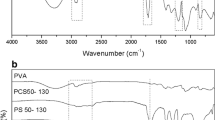Abstract
The polarity of rhamnolipid, a relatively hydrophilic biosurfactant, can be enhanced by the addition of linker molecules. In this work, rhamnolipid biosurfactant-modified surfaces were prepared with and without a combination of linkers (1-butanol, 1-octanol, and 1-dodecanol) to investigate effects of linker molecules on styrene adsolubilization and solubilization. Results showed that styrene adsolubilization increased with increasing carbon chain lengths of the linker molecules whereas the solubilization of styrene exhibited the opposite effect. Decreasing the carbon atoms in the linker molecules resulted in higher styrene solubilization capacity because of the change in polarity of the three-dimensional surfactant aggregates. The higher adsolubilization capacity indicated the enlargement of surfactant tails that was created a larger adsolubilization region in the admicelle while the lesser solubilization of styrene indicated the decreasing of affective area per molecule of the surfactant-linker system (butanol > octanol > dodecanol).




Similar content being viewed by others
References
Piver WT (1992) Contamination and restoration of groundwater aquifers. Environ Health Persp 100:237–247
Gawade AS, Vanjara AK, Sawant MR (2005) Removal of herbicide from water with sodium chloride using surfactant treated alumina for wastewater treatment. Sep Purif Technol 41:65–71
Adak A, Bandyopadhyay M, Pal A (2005) Removal of crystal violet dye from wastewater by surfactant-modified alumina. Sep Purif Technol 44:139–144
Charoensaeng A, Sabatini DA, Khaodhiar S (2008) Styrene solubilization and adsolubilization on an aluminum oxide surface using linker molecules and extended surfactants. J Surfact Deterg 11:61–71
Asnachinda E, Khaodhiar S, Sabatini DA (2009) Effect of ionic head group on admicelle formation by polymerizable surfactants. J Surfact Deterg 12:379–386
Attaphong C, Asnachinda E, Charoensaeng A, Sabatini DA, Khaodhiar S (2010) Adsorption and adsolubilization of polymerizable surfactants on aluminum oxide. J Colloid Interface Sci 344:126–131
Patoczka J, Pulliam GW (1990) Biodegradation and secondary effluent toxicity of ethoxylated surfactants. Wat Res 8:965–972
Desai J, Banat I (1997) Microbial production of surfactants and their commercial potential. Microbiol Mol Biol R 61:47–64
Joshi S, Bharucha C, Jha S, Yadav S (2008) Biosurfactant production using molasses and whey under thermophilic conditions. Bioresour Technol 99:195–199
Kiran GS, Sabu A, Selvin J (2010) Synthesis of silver nanoparticles by glycolipid biosurfactant produced from marine Brevibacterium casei MSA 19. J Biotechnol 148:221–225
Kosaric N (1992) Biosurfactants in industry. Pure Appl Chem 64:1731–1737
McCray JE, Bal G, Maler RM, Brusseau ML (2001) Biosurfactant-enhanced solubilization of NAPL mixtures. J Contam Hydrol 48:45–68
Nguyen TT, Youssef NH, Mclnerney M, Sabatini DA (2008) Rhamnolipid biosurfactant mixtures for environmental remediation. Wat Res 42:1734–1743
Yin H, Qiang J, Jia Y, Ye J, Peng H, Qin H, Zhang N, He B (2009) Characteristics of biosurfactant produced by Pseudomonas aeruginosa S6 isolated from oil-containing wastewater. Process Biochem 44:302–308
Wu J, Harwell JH, O’Rear EA (1987) Two-dimensional reaction solvents: surfactant bilayers in the formation of ultrathin films. Langmuir 3:531–537
Tan Y, O’Haver JH (2004) Lipophilic linker impact on adsorption of and styrene adsolubilization in polyethoxylated octylphenols. Colloids Surf A 232:101–111
Rosen MJ (2004) Surfactant and interfacial phenomena. John Wiley, NJ 444
Graciaa A, Lachaise J, Cucuphat C, Bourrel M, Salager JL (1993) Improving solubilization in microemulsions with additives. 1 The lipophilic linker role. Langmuir 9:669–672
Sun S, Jaffé PR (1996) Sorption of phenanthrene from water onto alumina coated with dianionic surfactants. Environ Sci Technol 30:2906–2913
Salager J-L, Graciaa A, Lachaise J (1998) Improving solubilization in microemulsions with additives. Part III: lipophilic linker optimization. J Surfact Deterg 1:403–406
Asnachinda E, Khaodhiar S, Sabatini DA (2010) Styrene and phenylethanol adsolubilization of a polymerizable gemini surfactant. J Surfact Deterg 13:143–148
Saphanuchart W, Saiwan C, O’Haver JH (2007) Effect of adsolubilized solutes on 2-D structure of cationic admicelles. Colloids Surf A 307:71–76
Xie Y-W, Li Y, Ye R-Q (2005) Effect of alcohols on the phase behavior of microemulsions formed by a biosurfactant—rhamnolipid. J Dispersion Sci Technol 26:455–461
Akatsu H, Hoyer R, Ramachandran R (1999) Method to minimize watermarks on silicon substrates. US Patent 5,932,493 August 3, 1999
Acknowledgments
The authors would like to express their appreciation to the Thailand Research Fund, Office of the Higher Education Commission, and Burapha University for the financial support for this work (Grant no. MRG5580061). In addition, the fund from the CU Graduate School thesis grant of Chulalongkorn University and Rachadaphiseksomphot Endowment Fund Part of the “Strengthen Chulalongkorn University Researcher’s Project” are gratefully acknowledged. This gratitude is also extended for the technical support provided by the Department of Environmental Engineering, Faculty of Engineering, Chulalongkorn University, Thailand.
Author information
Authors and Affiliations
Corresponding author
About this article
Cite this article
Asnachinda, E., Khampaeng, C., Sutthinon, P. et al. Enhancement of Styrene Adsolubilization and Solubilization by Rhamnolipid Biosurfactant-Linker Mixtures onto an Aluminum Oxide Surface. J Surfact Deterg 18, 439–444 (2015). https://doi.org/10.1007/s11743-015-1670-1
Received:
Accepted:
Published:
Issue Date:
DOI: https://doi.org/10.1007/s11743-015-1670-1




